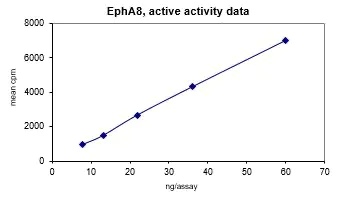EphA8, active Human Recombinant Kinase Protein
N-terminal 6His-tagged recombinant, human EphA8 amino acids 615-911.
Biological information
Background
Eph (erythropoietin-producing hepatocellular) family tyrosine kinase receptors consist of two groups: EphA group members respond to ephrin-A, which is anchored to the cell membrane by glycosylphosphatidylinositol, whereas EphB group members respond to ephrin-B, containing a transmembrane domain. Among them, only EphA4 can cross-respond to both ephrin-A and -B. The expression of EphA8 receptor significantly promoted cell attachment to fibronectin without altering cellular integrin levels. Moreover, p110 phosphotidylinositol (PI) 3-kinase plays as a key bridging molecule between EphA8 and integrins. Inhibition. of EphA8 may disrupt establishment, maintenance, and remodeling of patterns of cellular organization and may also be used in the treatment of various cancers.
GenBank NM_020526
Target class
Kinase
Family
TK
Accession number
NM_001006943.1; NM_020526.3
Target Name
EphA8, active Human Recombinant Kinase Protein
Target Alias
EPHA8, HEK3, KIAA1459, EphA8, EEK, Hek3
Origin
Human
Theori. MW
37.1 kDa
Affinity tag
6His
Product specifications
Expression system
Expressed by baculovirus in Sf21 insect cells
Purity
Refer to CoA for Purity
Purification method
Ni2+/NTA-agarose
Sample Buffer
Specified activity
Refer to CoA
Application
For Research Only
Storage conditions
6 months at -70°C
Usage disclaimer
For Research Only
Chemical data
Background
Eph (erythropoietin-producing hepatocellular) family tyrosine kinase receptors consist of two groups: EphA group members respond to ephrin-A, which is anchored to the cell membrane by glycosylphosphatidylinositol, whereas EphB group members respond to ephrin-B, containing a transmembrane domain. Among them, only EphA4 can cross-respond to both ephrin-A and -B. The expression of EphA8 receptor significantly promoted cell attachment to fibronectin without altering cellular integrin levels. Moreover, p110 phosphotidylinositol (PI) 3-kinase plays as a key bridging molecule between EphA8 and integrins. Inhibition. of EphA8 may disrupt establishment, maintenance, and remodeling of patterns of cellular organization and may also be used in the treatment of various cancers.
GenBank NM_020526
Compound name
Kinase
Catalog number
14-673
Molecular formula
CAS
MW
Ka
Percent composition
Product specifications
Physical state
Purity (HPLC 214nm)
Retention time (RP18 HPLC)
CMC
Exact mass
Stability
For Research Only
Solubility structure
Kinase Activity Assay Biological information
Background
Eph (erythropoietin-producing hepatocellular) family tyrosine kinase receptors consist of two groups: EphA group members respond to ephrin-A, which is anchored to the cell membrane by glycosylphosphatidylinositol, whereas EphB group members respond to ephrin-B, containing a transmembrane domain. Among them, only EphA4 can cross-respond to both ephrin-A and -B. The expression of EphA8 receptor significantly promoted cell attachment to fibronectin without altering cellular integrin levels. Moreover, p110 phosphotidylinositol (PI) 3-kinase plays as a key bridging molecule between EphA8 and integrins. Inhibition. of EphA8 may disrupt establishment, maintenance, and remodeling of patterns of cellular organization and may also be used in the treatment of various cancers.
GenBank NM_020526
Target class
Kinase
Family
TK
Subfamily
Protein Name
EphA8
Protein Alias
EPHA8, HEK3, KIAA1459, EphA8, EEK, Hek3
Accession Number
NM_001006943.1; NM_020526.3
UniProt Number
Gene Name
Gene ID
Gene Aliases
Target Species
Human
Kinase Activity Assay Usage
Product Type
Application
Storage Conditions
6 months at -70°C
Usage disclaimer
Kinase Activity Assay Information
Assay Type
Assay Measures
Biological Information
Background
Eph (erythropoietin-producing hepatocellular) family tyrosine kinase receptors consist of two groups: EphA group members respond to ephrin-A, which is anchored to the cell membrane by glycosylphosphatidylinositol, whereas EphB group members respond to ephrin-B, containing a transmembrane domain. Among them, only EphA4 can cross-respond to both ephrin-A and -B. The expression of EphA8 receptor significantly promoted cell attachment to fibronectin without altering cellular integrin levels. Moreover, p110 phosphotidylinositol (PI) 3-kinase plays as a key bridging molecule between EphA8 and integrins. Inhibition. of EphA8 may disrupt establishment, maintenance, and remodeling of patterns of cellular organization and may also be used in the treatment of various cancers.
GenBank NM_020526
Target class
Kinase
Family
TK
Accession Number
NM_001006943.1; NM_020526.3
Target Name
EphA8
Target Alias
EPHA8, HEK3, KIAA1459, EphA8, EEK, Hek3
Origin
Human
Theoretical MW
Affinity Tag
6His
Product Specifications
Expression system
Expressed by baculovirus in Sf21 insect cells
Purity
Refer to CoA for Purity
Purification method
Ni2+/NTA-agarose
Sample Buffer
Specified activity
Refer to CoA
Application
Storage conditions
6 months at -70°C
Usage disclaimer
For Research Only
Biological Information
Background
Eph (erythropoietin-producing hepatocellular) family tyrosine kinase receptors consist of two groups: EphA group members respond to ephrin-A, which is anchored to the cell membrane by glycosylphosphatidylinositol, whereas EphB group members respond to ephrin-B, containing a transmembrane domain. Among them, only EphA4 can cross-respond to both ephrin-A and -B. The expression of EphA8 receptor significantly promoted cell attachment to fibronectin without altering cellular integrin levels. Moreover, p110 phosphotidylinositol (PI) 3-kinase plays as a key bridging molecule between EphA8 and integrins. Inhibition. of EphA8 may disrupt establishment, maintenance, and remodeling of patterns of cellular organization and may also be used in the treatment of various cancers.
GenBank NM_020526
Target class
Kinase
Family
TK
Accession Number
NM_001006943.1; NM_020526.3
Target Name
EphA8
Target Alias
EPHA8, HEK3, KIAA1459, EphA8, EEK, Hek3
Origin
Human
Theoretical MW
Affinity Tag
6His
Product Specifications
Expression system
Expressed by baculovirus in Sf21 insect cells
Purity
Refer to CoA for Purity
Purification method
Ni2+/NTA-agarose
Sample Buffer
Specified activity
Refer to CoA
Application
Storage conditions
6 months at -70°C
Usage disclaimer
For Research Only





